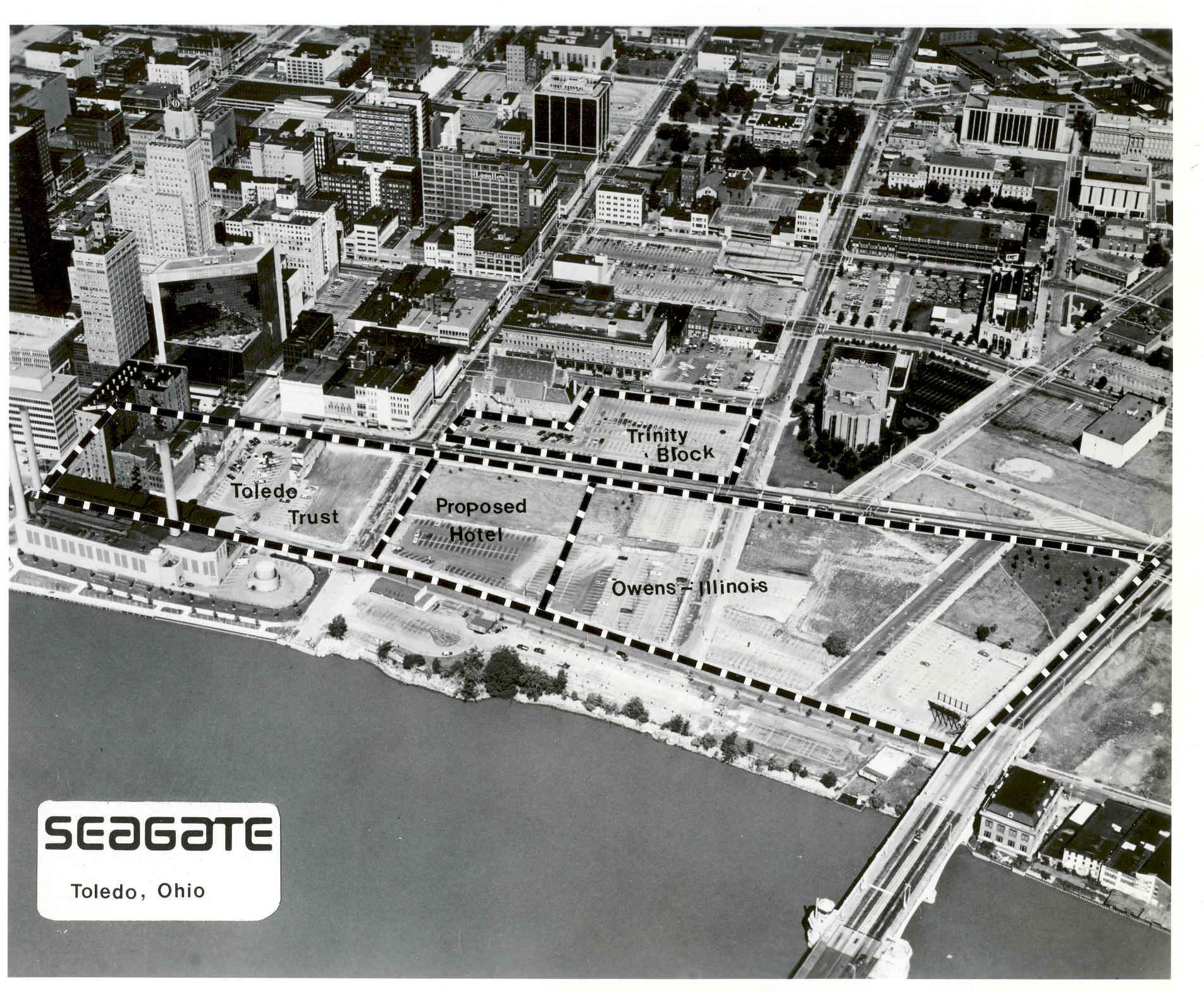
Owens-Illinois Today and Tomorrow
The past quarter century of the history of Owens-Illinois has been perhaps its most dramatic. The high points included the construction of a new headquarters housed in a sparkling glass skyscraper downtown, the diversification into new industries, the acquisition of additional glassware companies to strengthen the company's bottom line, and a move to a new headquarters in Perrysburg. The low points included a severe economic recession in the 1980s that resulted in a large number of plant closings and employee layoffs, and the takeover of the company in 1987 during a frantic period of leveraged corporate buyouts that would affect not only O-I, but other Toledo corporations as well.
The company assumed a high profile during the first half of the 1980s as it became a partner in a plan of city fathers to revitalize downtown Toledo. During decades of decline, Toledo's once thriving downtown riverfront became cluttered with rotting wharves, abandoned warehouses, and acres of unused parking lots. An effort to revitalize the area began with the creation of the Greater Toledo Corporation in 1973 and the Toledo Development Committee in 1974, groups led by business, government, and civic leaders whose mission it was to guide the revitalization. The first plan proposed included a new government office building, a marina, shops, restaurants, and residences.
In the meantime, Owens-Illinois,
under the leadership of CEO Edwin D. Dodd, was examining alternatives for the expansion and consolidation of its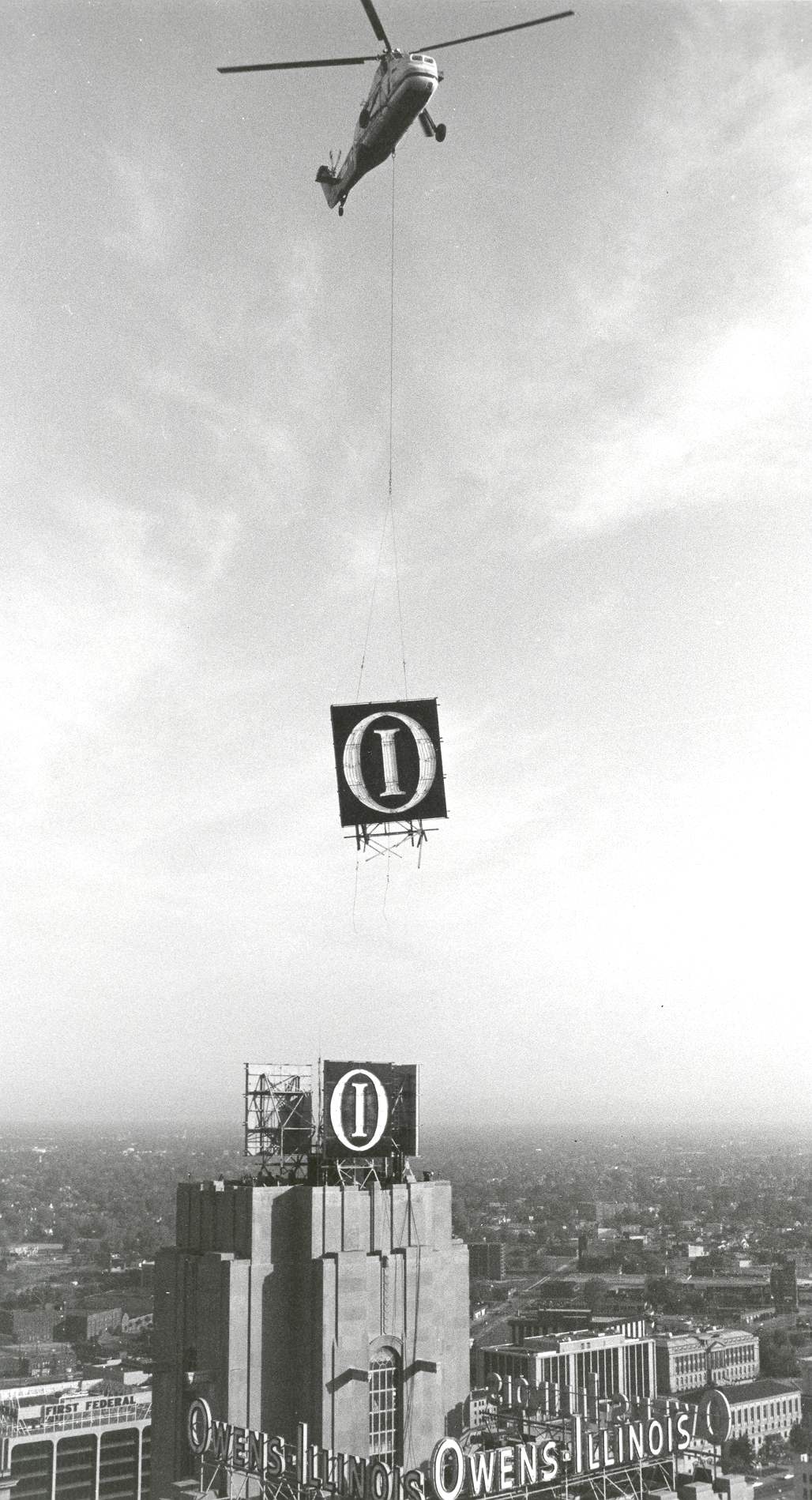 headquarters operations. Although it had been one of four sponsors of an Urban Land
Institute study of the downtown area and had worked to generate community interest in revitalization (in fact, Dodd was the first chairman of the
Greater Toledo Corporation), it was also considering the options of moving to the suburbs or to another city. In order to keep the
corporation in downtown Toledo, City Council offered to sell it a ten-acre site next to the river and give it major responsibility for the
riverfront redevelopment project. After much study and negotiation, the company agreed to the city's proposal, and purchased the site in
1979. As Dodd stated,"Revitalization of the entire downtown is of critical importance to Owens-Illinois." Groundbreaking was held
later that year for a new corporate headquarters building and adjacent plaza, now known as One SeaGate.
headquarters operations. Although it had been one of four sponsors of an Urban Land
Institute study of the downtown area and had worked to generate community interest in revitalization (in fact, Dodd was the first chairman of the
Greater Toledo Corporation), it was also considering the options of moving to the suburbs or to another city. In order to keep the
corporation in downtown Toledo, City Council offered to sell it a ten-acre site next to the river and give it major responsibility for the
riverfront redevelopment project. After much study and negotiation, the company agreed to the city's proposal, and purchased the site in
1979. As Dodd stated,"Revitalization of the entire downtown is of critical importance to Owens-Illinois." Groundbreaking was held
later that year for a new corporate headquarters building and adjacent plaza, now known as One SeaGate.
Others joined O-I in the redevelopment project. In 1978 the Toledo Trust Company, a local bank with a long history in the community, announced plans to build a new headquarters on the south end of the development, and moved into its new triangular-shaped granite and glass building in 1981. Promenade Park was improved and enlarged to stretch from Monroe Street to Cherry Street, and included an outdoor amphitheater, seating areas, boat docks, overlooks, and walking paths. In 1982 ground was broken for Portside Festival Marketplace, a retail development that housed unique retail shops and restaurants, and next to it, Hotel Sofitel, a luxury hotel with rooms, restaurants, and event space that could accommodate 1000 people. In addition to the developments along the riverfront, a new city-county-state office building was constructed at the corner of Erie and Jackson streets called One Government Center, and Jackson Street was converted to a boulevard linking downtown to the riverfront.
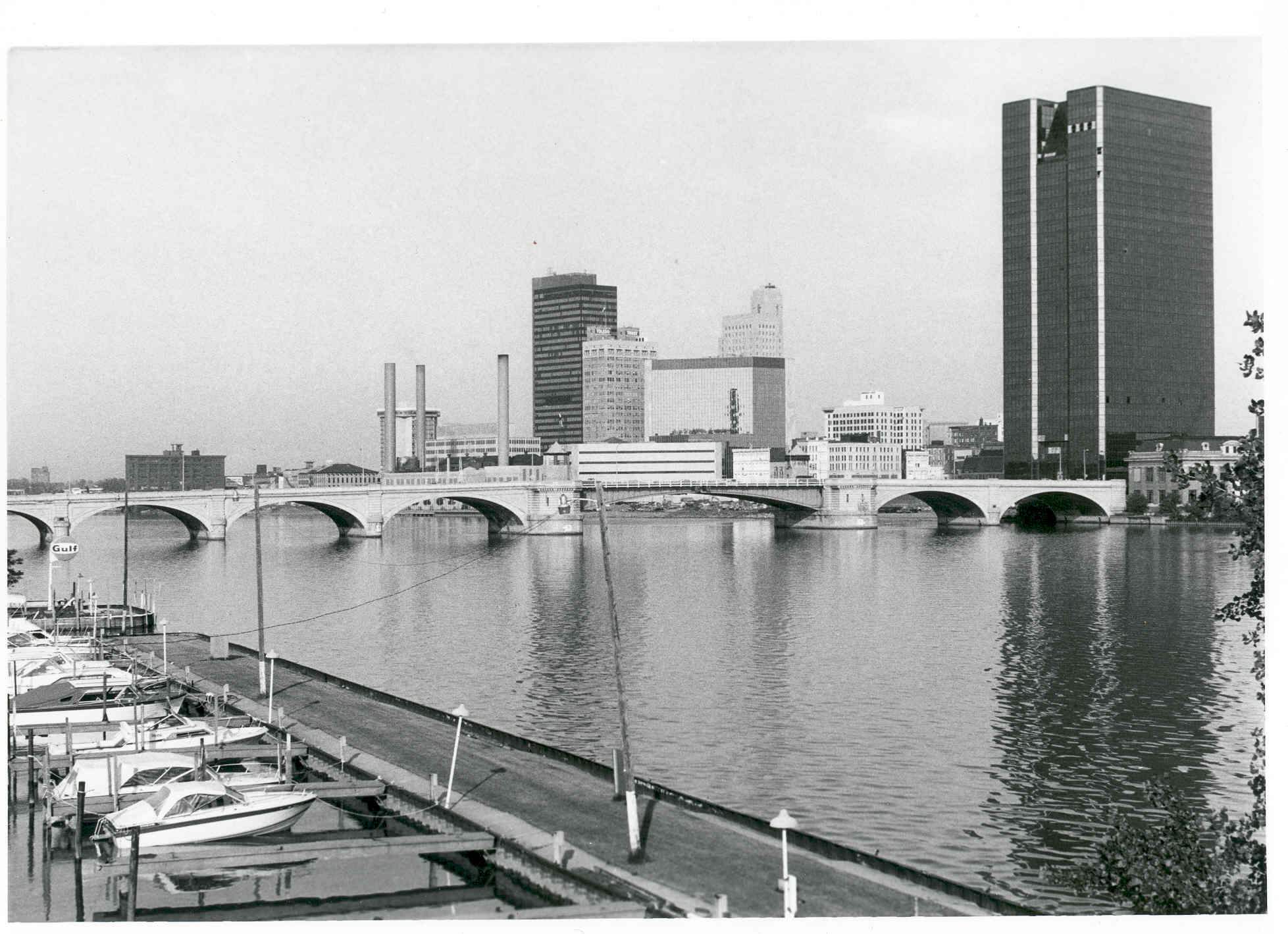 The
entire project was dominated by Owens-Illinois's One SeaGate headquarters building. When it opened in 1981, the thirty-two story, 411-feet
tall steel and glass skyscraper was Toledo's tallest building (and still is). Its 900,000 square feet of office space and adjoining plaza
occupied the corner of Summit Street and Jackson Boulevard with a view of the Maumee River and Promenade Park. A pedestrian concourse
system connected the development to the bus transit loop, the city parking garage, the new hotel, and other office buildings. The large O-I
sign, a familiar icon on the Toledo skyline that topped its old headquarters building, was donated to Owens Community College and moved to the
campus after being airlifted off the building by a helicopter.
The
entire project was dominated by Owens-Illinois's One SeaGate headquarters building. When it opened in 1981, the thirty-two story, 411-feet
tall steel and glass skyscraper was Toledo's tallest building (and still is). Its 900,000 square feet of office space and adjoining plaza
occupied the corner of Summit Street and Jackson Boulevard with a view of the Maumee River and Promenade Park. A pedestrian concourse
system connected the development to the bus transit loop, the city parking garage, the new hotel, and other office buildings. The large O-I
sign, a familiar icon on the Toledo skyline that topped its old headquarters building, was donated to Owens Community College and moved to the
campus after being airlifted off the building by a helicopter.
At the time One SeaGate was completed, Toledo was headquarters for seven Fortune 500 companies: Champion Spark Plug, Dana, Libbey-Owens-Ford, Owens- Corning, Sheller-Globe, Questor, and Owens Illinois. All had substantial workforces in Toledo. The new skyscraper was the frosting on a gleaming new downtown, and Toledo seemed to finally be shaking its inferiority complex and taking its place as a world-class city.
From a business standpoint, Owens-Illinois undertook several important new ventures in the early 1980s. In 1982, the corporation re-organized to create a health care group. This unit included pharmaceutical packaging operations; the Kimble Division, which made scientific glassware; and a new company from Nashville, Tennessee, called Health Group Incorporated. The latter was a hospital management group that owned several nursing homes. Company leaders felt that diversifying into health care, a rapidly growing industry, would improve the company's profits and was a natural connection to O-I's business of producing health-care related glassware. In 1983, the company expanded its health care management by acquiring Health Care and Retirement Corporation of America, then headquartered in Lima, Ohio. Owens-Illinois became the sixth largest operator of long-term health care facilities in the country.
But the national recession of the late 1970s and early 1980s took its toll on the company, despite its efforts at diversification. Between 1980 and 1983, O-I shut down 42 of its foreign and domestic production facilities and eliminated 17,000 employees. One of the plants closed was the Alton, Illinois, factory where Illinois Glass began. Many white-collar workers in Toledo were offered early retirement incentives in an effort to reduce the workforce. The biggest personnel changes were the retirements of Ed Dodd as CEO and William Spengler as vice chairman of the board, and the rise of Robert Lanigan as CEO. Lanigan continued expansion in the health care, plastics, and financial service businesses.
Ironically, it was the success of the company that made it attractive as a corporate takeover entity. In late 1986, Kohlberg Kravis Roberts and Company, a firm that specialized in leveraged buyouts, began talking to Lanigan and others about Owens-Illinois. Leveraged buyouts were a popular method of corporate acquisition in the 1980s, which involved borrowing large amounts of money to purchase a majority of stock in a company using the assets of the acquired firm as collateral. Once acquired, many of the company's assets (including profitable divisions) were sold to pay down the debt. After initial rejection of KKR's offer, in February 1987 the deal was finally accepted at a cost of $3.66 billion. As of March of that year, Owens-Illinois was a privately held company.
The period of corporate takeovers in the late 1980s was devastating to Toledo, and to the grand scheme for revitalizing downtown. Many of the major firms were purchased by outsiders, and operations moved elsewhere. Banking scandals claimed several major financial institutions, including Toledo Trust. With severely downsized companies and workforces, the hope of a new downtown died. Perhaps best known of the failures was Portside Festival Marketplace, which closed its doors in 1990. O-I's operations at its headquarters were significantly downsized during this period.
In the years immediately following the takeover of O-I by KKR, many operations of the company were sold off, including the Forest Products Division, several overseas ventures, its financial services business, and the Owens-Illinois Technical Center (which was sold to the University of Toledo). In 1991, the Health Care and Retirement Corporation of America was spun off as a separate entity, which would become HCR Manor Care. But at the same time, the company did acquire Brockway, Inc., the third largest container manufacturer in the country.
On the positive side, the sale of these large divisions (particularly HCR) provided needed capital to take Owens-Illinois public. In December 1991, O-I stock was publicly traded again. But to help reduce the indebtedness, in 1993 the company ended its long affiliation with Libbey Glass, which was sold off.
The company celebrated its one hundredth anniversary in 2003 by sponsoring a video detailing the company's history produced and aired by WGTE Public Broadcasting. In 2005, Owens-Illinois announced that it was moving from its downtown headquarters in One SeaGate to a new building in its Levis Development Park in Perrysburg, where many of its operations and employees were already located. This move will be completed by the end of 2006.
At the Ward M. Canaday Center for Special Collections
Photographs, downtown revitalization briefing book, ca. 1980. O-I, MSS-200.
This briefing book was put together for local media to promote the plans for downtown revitalization that included a new Owens-Illinois world headquarters. Included were photographs showing the proposed new buildings.
Speeches by Edwin D. Dodd on downtown revitalization, 1977-1980. Jack Paquette Papers, MSS-169. (Finding Aid)
Edwin Dodd became one of the leaders of the downtown revitalization effort, and often spoke of its importance to the company and to the city.
Photographs and mementos, One SeaGate groundbreaking and "topping out" ceremonies, 1979-1980.
O-I, MSS-200.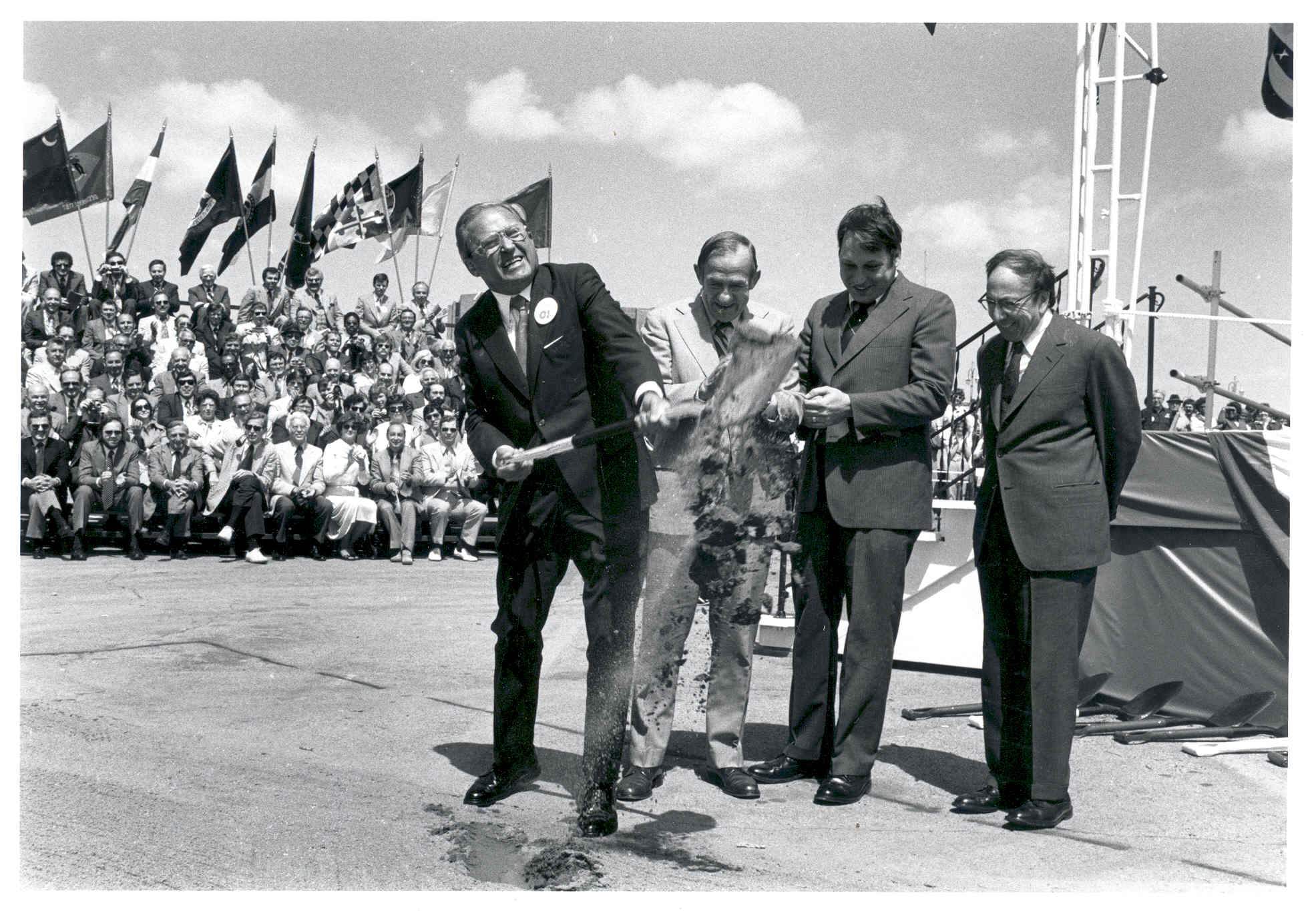
The groundbreaking ceremonies for One SeaGate drew some important dignitaries, including Mayor Douglas DeGood, Congressman Ludlow Ashley, Blade publisher Paul Block, Jr., and O-I CEO Edwin Dodd. After the dignitaries turned the first shovels, others were invited to join in, including O-I employees. Included here is one of the silver-plated shovels used to break ground. Another ceremony was held on July 7, 1980, to commemorate the placement of the last beam of the building. For each event, O-I's Libbey division produced commemorative glasses.
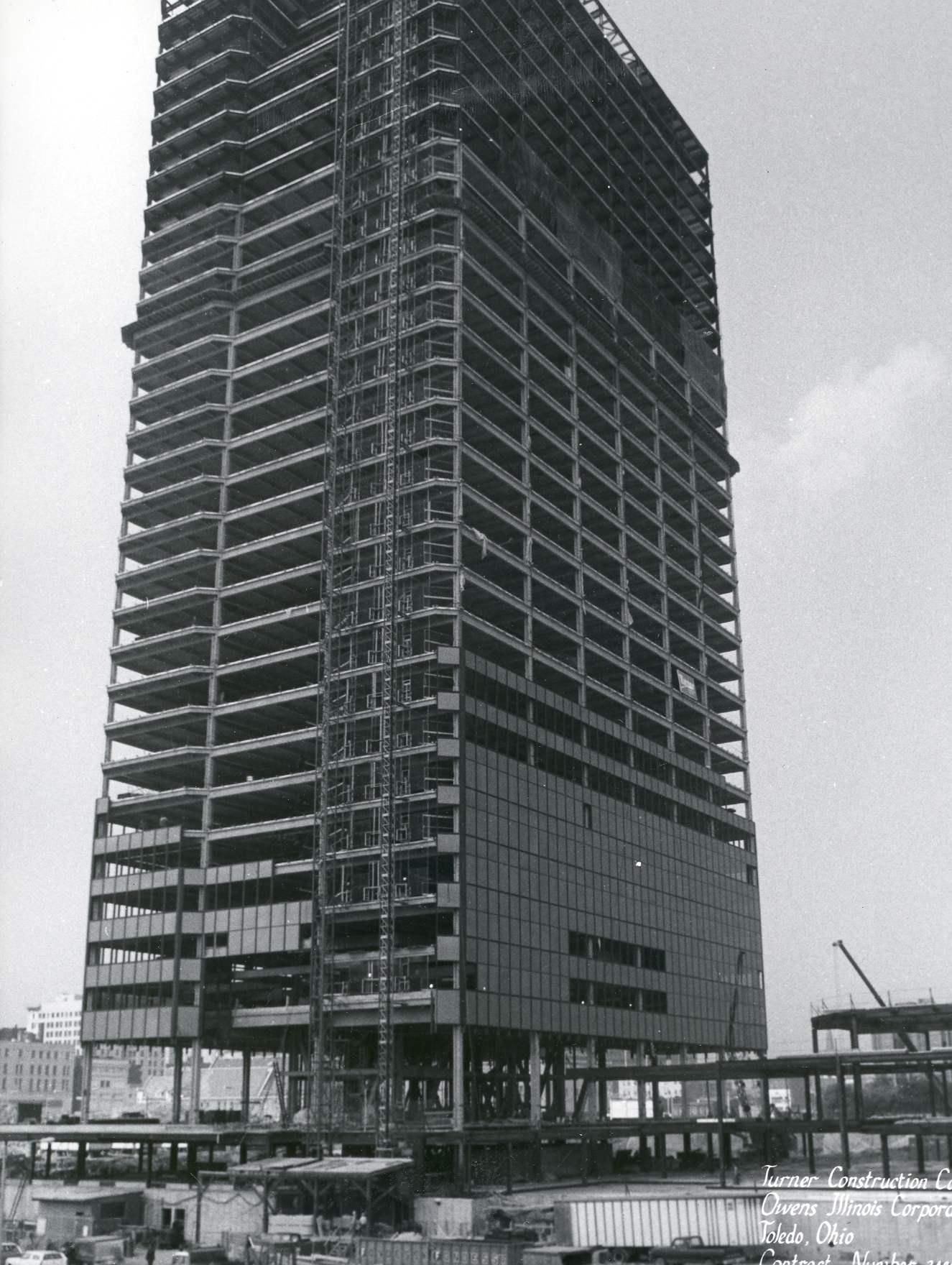 Construction
photographs, One SeaGate, 1979-1981. O-I, MSS-200.
Construction
photographs, One SeaGate, 1979-1981. O-I, MSS-200.
These photos document progress on the world headquarters building, from initial site preparation to the nearly finished building.
Commemorative plaque, Kohlberg Kravis Roberts acquisition, 1987. O-I, MSS-200.
This plaque from Goldman, Sachs & Co. marked the acquisition of Owens-Illinois by KKR.
Medallion, original listing of Owens-Illinois, Inc. on the New York Stock Exchange, 1991. O-I, MSS-200.
In 1991, O-I went public again, and this marked the occasion of the return of the company to the NYSE.
Prospectus for the sale of Libbey, Inc., 1993. O-I, MSS-200.
In 1993, O-I divested itself of Libbey, Inc., ending a long history between the two firms that began back in 1888 when Michael Owens was hired by Edward Drummond Libbey. Libbey had been a division of Owens-Illinois since 1935.